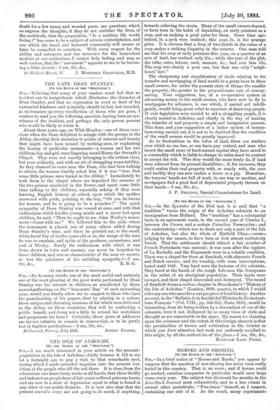[TO THE EDITOR OF THE "SPECTATOR."]
the Spectator of the 23rd inst. it is said that "a tradition" traces the origin of the Axholme colonists to an immigration from Holland. The "tradition" has a substantial basis in an agreement made, in the second year of Charles I., between the Crown and a certain Cornelius Vermuyden ; and the undertaking—which was to drain not only a part of the Isle of Axholme, but also the whole of Hatfield Chace—seems, judging by the names, to have been at first almost exclusively Dutch. That the settlement should attract a fair number of French Protestants was natural; it was soon after the capture of La Rochelle, and the Huguenots were in a volatile condition. There was a chapel for them at Sandtoft, with alternate French and Dutch service ; and the worship, with some interruptions, lasted until 1681. Very hard were the fortunes of the colonists._ They fared at the hands of the rough Isle-men like Europeans in the midst of an aboriginal population. Their lands were ravaged, and their chapel desecrated and destroyed. The record of Sandtoft forms a curious chapter in Stonehouse's "History of the Isle of Axholme" (London, 1839, quarto), to which I would refer any one who cares for a unique piece of local history. Another account, in the "Bulletin de la Soci6te de l'Histoire du Protestant- isme Francais " (Vol. VIII., pp. 344-352; Paris,1859), would be interesting, from its being written by a descendant of one of the colonists, were it not disfigured by as many vices of style and thought as are conceivable in the space. My reason for insisting upon the existence and the extent of this foreign element is that the peculiarities of tenure and cultivation in the district to which you drew attention last week are uniformly ascribed to this origin, by all the authorities of the place.—I am, Sir, &c.,
REGINALD LINE POOLE.


































 Previous page
Previous page